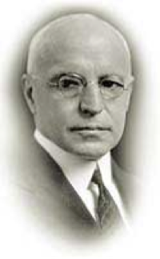
As stated in part one of this series, an entrepreneur is a person who assumes the risk of a business, who is a visionary, and who invents new products and services, making them available to the general public, and thus enriching our lives and their own pocketbooks. Such a person was Albert Bond Lambert who died at his home in St. Louis November 12, 1946 after a life of activity, accomplishments and service. In 1896 at the age of 21, Albert “Al” Lambert took over the family’s St. Louis business, the Lambert Pharmacal Company started by his father, Jordon Lambert, in 1879.
The company had one product which was a surgical antiseptic called Listerine. This first over-the-counter mouthwash was named in honor of Dr. Joseph Lister, pioneer of antiseptic surgery. It has been stated, “Listerine did not make mouthwash as much as it made halitosis." Lambert’s ads featured forlorn young women and men, eager for marriage but turned off by their mate's rotten breath. "Can I be happy with him in spite of that?" one maiden asked herself. Through effective advertising by Al Lambert, the company's revenues rose from $115,000 to more than $8 million. His company was eventually acquired by the inventor of coated pills, William R. Warner, and became knows as the Warner-Lambert Co, and later bought out by Pfizer in the year 2000.
As the pharmaceutical business grew so did Al Lambert’s wealth. As a millionaire he was able to spend more time at the game of golf. While on business at his Paris office, he entered the 1900 Summer Olympic golf event in Compiègne, France finishing eighth. When plans were being made for the 1904 Olympics in St. Louis, Lambert and his father-in-law, Col. George McGrew, were instrumental in bringing golf to their own Glen Echo Country Club. Lambert, a left-handed golfer and only 5 foot 6 inches tall, joined in with an Olympic team from St. Louis and made it to the quarter-finals in match play. Al Lambert was also a winner in the handicap event with a score of 94-95 and became one of the first Americans to win an Olympic silver metal.
Although Al enjoyed the game of golf, he loved aviation even more. He was an avid balloonist and developed many friendships in the flying community, including the Wright Brothers and Glen Curtis. Early in 1907, he helped organize the Aero Club of St. Louis and purchased a balloon launching site near St. Louis, which he later gave to the city for an airport (now Lambert-St. Louis International). He took flying lessons from Orville Wright and acquired St. Louis’ first pilot’s license in 1911. During World War I he became a Major in the Aviation Section of the United States Army Signal Corps, being an instructor in ballooning and parachuting.
As a visionary Major Albert B. Lambert could see the future of aviation in America. When Charles Lindbergh walked into his office in February of 1927 looking for money to build a single engine airplane to fly from New York to Paris, Major Lambert was the first to pledge $1,000 toward the flight. He then encouraged 8 of his business associates to provide the complete financing of Lindbergh’s transatlantic journey. In appreciation of the money Lindbergh named his plane the Spirit of St. Louis. With flight-testing completed, Lindy took off from San Diego, stopping at Lambert Field in St. Louis, and arrived in New York on May 12th. You all know the rest of the story, but did you know that it was Listerine that made Lindbergh’s historical flight possible?
